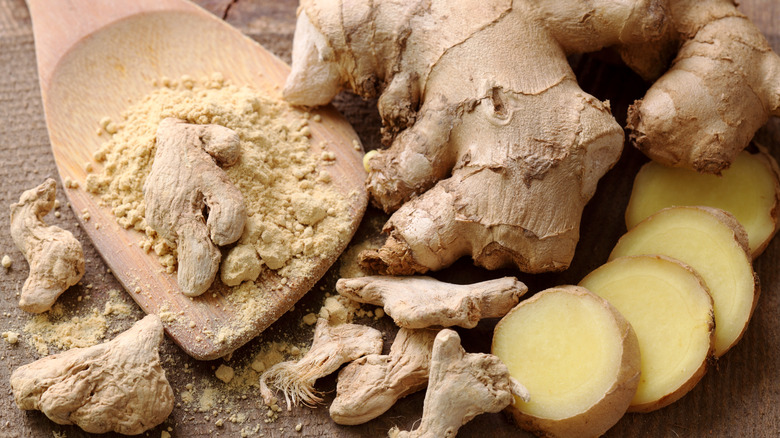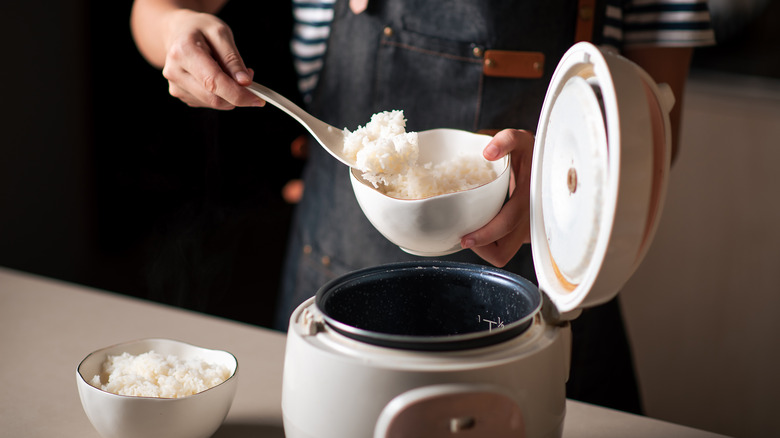Add Ginger To White Rice For An Added Touch Of Flavor
Whether you're cooking it into a stir-fry or adding it to a chicken soup, white rice is a widely-used kitchen ingredient used everywhere from New Orleans to Nepal and everywhere in between. Versatile and filling, there's only one downside to this utilitarian ingredient — it doesn't have a strong flavor of its own. Beyond its starchy and tender texture, white rice is bland. Even when it's combined with other sauces, proteins, and cooking oils, it can still fall flat. However, with the help of one common root vegetable, you can take white rice from ordinary to extraordinary. Enter ginger.
Ginger gives white rice a mildly spicy, fragrant, and warming essence, providing it with more depth of flavor while inviting a dash of sophistication to its neutral flavor profile. On a microscopic level, ginger's pronounced flavor is attributed to chemical compounds called gingerol and ketones. These compounds also give ginger its pleasantly intense aroma that you can smell as much as you can taste. Plus, ginger has many nutritional benefits. From its anti-inflammatory bravado to its propensity for curing a stomach ache, introducing ginger to a batch of white rice provides it with a touch of vigor.
Tips for making ginger rice
Adding ginger to white rice is a simple process that even foodies new to cooking can successfully achieve. However, there are a few tips worth keeping in mind to maintain a proper balance of flavor.
For starters, whether you use freshly grated ginger or store-bought ground ginger is ultimately up to you. But bear in mind that ground ginger has a less pungent flavor than its fresh counterpart, so you might consider using about three times as much ground ginger as you would fresh. But remember, because it does have a strong flavor in any form, a little bit can go a long way with ginger. If you're using fresh ginger, a good guideline is to use two tablespoons of ginger for every cup of rice (adjust accordingly for ground ginger). If you add too much ginger, a dash of acid via cooking vinegar or citrus juice or a drizzle of sweet molasses can remedy the situation.
Instead of adding ginger directly to the finished product, let it cook alongside the rice so its flavor bleeds into the entire batch. Thoroughly mix the ginger into the uncooked rice with water or broth and let it simmer in a lidded pot or rice cooker or until the rice has absorbed all of the liquid. If you want to jazz things up, heating the cooking liquid with ginger, butter, herbs, or even a dash of sugar before introducing the rice to the cooking liquid provides added depth of flavor.
Ginger rice dish ideas
Now that you're ready to whip up a batch of ginger rice to spice up your white rice routine, you'll need some ideas for putting it to good use. Luckily, ginger pairs well with a wide range of ingredients, so you'd be hard-pressed to run out of ways to utilize this spicy rice.
For something teeming with vibrant, fragrant flavors, consider combining ginger rice with well-seasoned chicken, bell peppers, mushrooms, and Asian sauces like fish sauce for a satiating meal that's likened to a Thai stir-fry called Gai Pad King. The umami-dense mushrooms provide a savory heartiness to the dish while the bell peppers give it a crunchy, refreshing lightness — all bolstered by the perfumed presence of the ginger rice.
Ginger rice also pairs well with vegetable dishes like steamed broccoli, air-fryer tenderized cabbage, fresh cucumber, and slivered carrots. Combined with steak, salmon, or even ginger-infused tofu, you'll have a well-rounded and flavorful meal. Don't hesitate to incorporate additional complementary spices like lemongrass, mint, garlic, and tamarind for a more robust flavor profile.
Don't hesitate to keep things simple, either. A bowl of ginger rice topped with a dash of soy sauce for savoriness and a runny fried egg for creamy richness is as easy to make as it is to enjoy. Ginger rice also works well in soups, sushi, air-fryer spring rolls, and Buddha bowls, so branch out and have fun discovering how this anything-but-ordinary rice dish fits into your weekly meal rotation.


